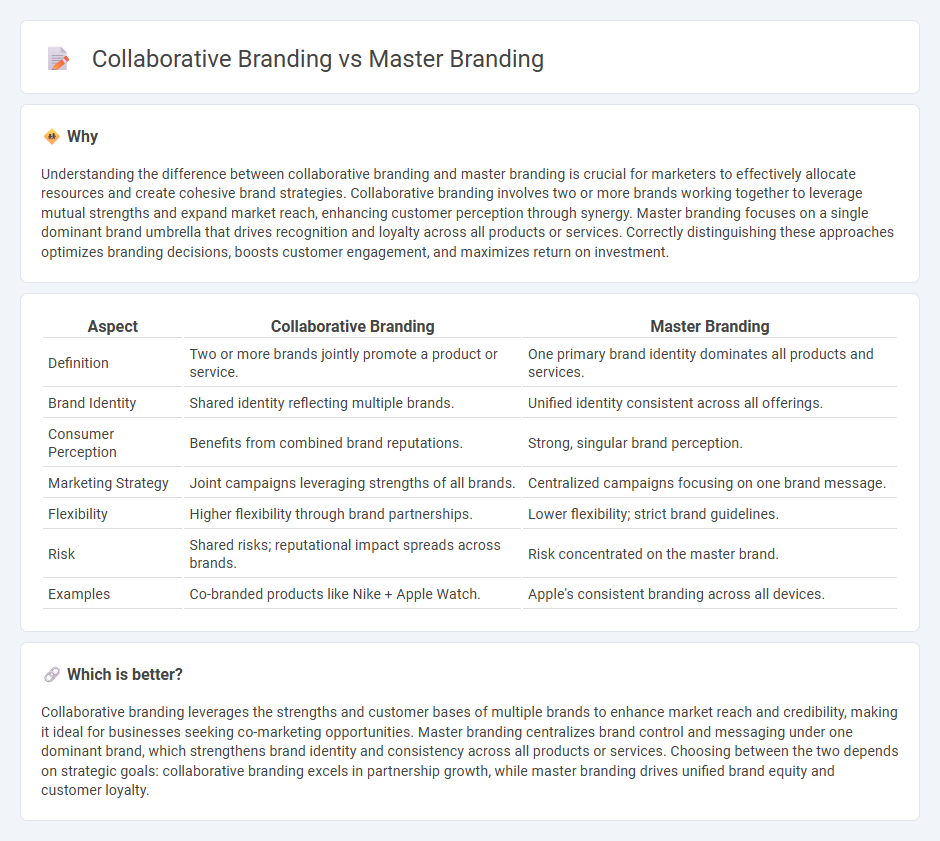
Collaborative branding leverages the strengths and audience reach of two or more brands to create synergistic value, enhancing market visibility and consumer trust. In contrast, master branding focuses on building a dominant, singular brand identity that governs product perception and loyalty across various offerings. Explore the strategic differences and benefits of collaborative versus master branding for your marketing approach.
Why it is important
Understanding the difference between collaborative branding and master branding is crucial for marketers to effectively allocate resources and create cohesive brand strategies. Collaborative branding involves two or more brands working together to leverage mutual strengths and expand market reach, enhancing customer perception through synergy. Master branding focuses on a single dominant brand umbrella that drives recognition and loyalty across all products or services. Correctly distinguishing these approaches optimizes branding decisions, boosts customer engagement, and maximizes return on investment.
Comparison Table
| Aspect | Collaborative Branding | Master Branding |
|---|---|---|
| Definition | Two or more brands jointly promote a product or service. | One primary brand identity dominates all products and services. |
| Brand Identity | Shared identity reflecting multiple brands. | Unified identity consistent across all offerings. |
| Consumer Perception | Benefits from combined brand reputations. | Strong, singular brand perception. |
| Marketing Strategy | Joint campaigns leveraging strengths of all brands. | Centralized campaigns focusing on one brand message. |
| Flexibility | Higher flexibility through brand partnerships. | Lower flexibility; strict brand guidelines. |
| Risk | Shared risks; reputational impact spreads across brands. | Risk concentrated on the master brand. |
| Examples | Co-branded products like Nike + Apple Watch. | Apple's consistent branding across all devices. |
Which is better?
Collaborative branding leverages the strengths and customer bases of multiple brands to enhance market reach and credibility, making it ideal for businesses seeking co-marketing opportunities. Master branding centralizes brand control and messaging under one dominant brand, which strengthens brand identity and consistency across all products or services. Choosing between the two depends on strategic goals: collaborative branding excels in partnership growth, while master branding drives unified brand equity and customer loyalty.
Connection
Collaborative branding leverages partnerships between two or more brands to create a unified marketing strategy that enhances visibility and credibility for all parties involved. Master branding establishes a dominant brand identity that drives consistency across various products and sub-brands, providing a foundation that collaborative efforts can build upon. Together, collaborative branding and master branding strengthen market positioning by combining shared creative resources with a cohesive brand narrative.
Key Terms
Brand Architecture
Master branding consolidates all products under a single, dominant brand name to strengthen brand equity and ensure consistent messaging, exemplified by companies like Virgin. Collaborative branding combines multiple distinct brands in partnerships or co-branded efforts to leverage complementary strengths and expand market reach, as seen in alliances between Red Bull and GoPro. Discover how strategic brand architecture can maximize your brand's impact and market positioning.
Co-Branding
Master branding centralizes a single brand identity across all products and services, ensuring consistency and strong brand recognition. Collaborative branding, specifically co-branding, combines two or more brands to leverage their unique strengths and expand market reach through joint marketing efforts. Explore deeper insights into how co-branding strategies can boost customer engagement and brand equity.
Brand Equity
Master branding centralizes brand equity by establishing a single, dominant brand identity that enhances recognition and loyalty across all products or services under one umbrella. Collaborative branding merges brand equities of multiple partners, leveraging combined strengths to create shared value and reach broader audiences while potentially diluting individual brand identities. Explore deeper insights into how each strategy impacts long-term brand equity and market positioning.
Source and External Links
Online Master of Design in Brand Design and Strategy Degree at ArtCenter - This program focuses on successful branding by combining graphic design, business, and leadership, teaching students to create compelling brand stories and strategies in a global market.
SVA Masters In Branding - An accelerated 10-month graduate degree exploring the role of brands in business, behavior, marketing, and culture, offering both online and in-person classes with a curriculum covering brand strategy, market research, and visual communication.
Master's Degree in Branding at LCI Barcelona - This program teaches strategic brand creation and management with a focus on brand strategy, identity, and experience, offering hands-on training in a creative environment in Barcelona.
 dowidth.com
dowidth.com